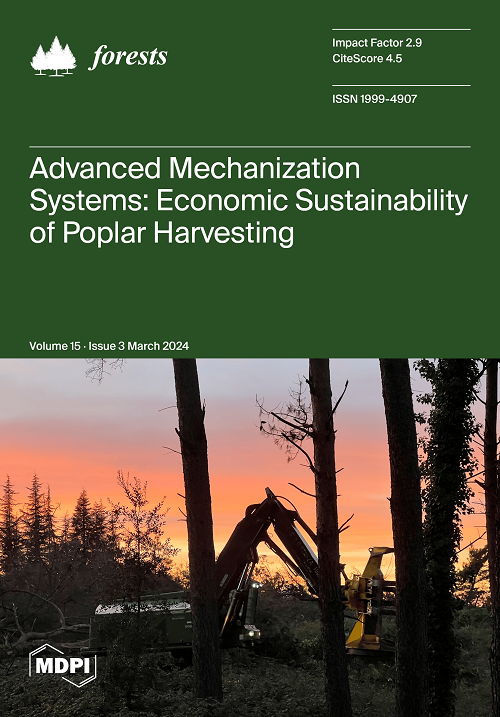A Compatible Estimation Method for Biomass Factors Based on Allometric Relationship: A Case Study on Pinus densata Natural Forest in Yunnan Province of Southwest China
IF 2.5
2区 农林科学
Q1 FORESTRY
引用次数: 0
Abstract
Using various biomass factors, such as biomass expansion factor (BEF) and biomass conversion and expansion factor (BCEF), yields different results for estimating forest biomass. Therefore, ensuring compatibility between total biomass and its components when employing different biomass factors is crucial for developing a set of rapid and efficient models for large-scale biomass calculation. In this study, allometric equations were utilized to construct independent models and the proportional values (root-to-shoot ratio (Rra), crown-to-stem ratio (Rcs), bark-to-wood ratio (Rbw), foliage-to-bark ratio (Rfb), and wood biomass-to-wood volume (ρ)) by using the mean height (Hm) and the mean diameter at breast height (Dg) of 98 Pinus densata plots in Shangri-La, Yunnan province, China. The compatible methods were applied to reveal the compatibility between the total biomass and each component’s biomass. The results showed the following: (1) Both the independent model and compatible model had a higher accuracy. The values were greater than 0.7 overall, but the foliage biomass accuracy was only 0.2. The total biomass and the component biomass showed compatibility. (2) The accuracy of BEF and BCEF exceeded 0.87 and the total error was less than 0.1 for most components. (3) The mean BEF (1.6) was greater than that of the Intergovernmental Panel on Climate Change (IPCC) (M = 1.3), and the mean BCEF was smaller than that of the IPCC; the values were 0.6 and 0.7, respectively. The range of BEF (1.4–2.1) and BCEF (0.44–0.89) were all within the range of the IPCC (1.15–3.2, 0.4–1.0). This study provides a more convenient and accurate method for calculating conversion coefficients (BEF and BCEF), especially when only Rcs data is available.基于异速关系的生物量因子兼容估算方法:中国西南部云南省松类天然林案例研究
使用不同的生物量因子,如生物量扩展因子(BEF)和生物量转换与扩展因子(BCEF),会产生不同的森林生物量估算结果。因此,在使用不同的生物量因子时,确保总生物量及其组成部分之间的兼容性,对于开发一套快速、高效的大规模生物量计算模型至关重要。在本研究中,利用异速方程构建了独立模型,并利用中国云南省香格里拉市 98 个松树地块的平均高度(Hm)和平均胸径(Dg)计算了比例值(根与芽比(Rra)、冠与茎比(Rcs)、树皮与木材比(Rbw)、叶与树皮比(Rfb)和木材生物量与木材体积比(ρ))。应用相容性方法揭示了总生物量与各组分生物量之间的相容性。结果表明(1)独立模型和兼容模型的准确度都较高。总体数值大于 0.7,但叶片生物量的精确度仅为 0.2。总生物量和组分生物量显示出兼容性。(2) BEF 和 BCEF 的精度超过 0.87,大部分成分的总误差小于 0.1。(3) BEF 的平均值(1.6)大于政府间气候变化专门委员会(IPCC)的平均值(M = 1.3),BCEF 的平均值小于 IPCC 的平均值,分别为 0.6 和 0.7。BEF(1.4-2.1)和 BCEF(0.44-0.89)的范围均在 IPCC(1.15-3.2,0.4-1.0)的范围之内。这项研究为计算转换系数(BEF 和 BCEF)提供了一种更方便、更准确的方法,尤其是在只有 Rcs 数据的情况下。
本文章由计算机程序翻译,如有差异,请以英文原文为准。
求助全文
约1分钟内获得全文
求助全文
来源期刊

Forests
FORESTRY-
CiteScore
4.40
自引率
17.20%
发文量
1823
审稿时长
19.02 days
期刊介绍:
Forests (ISSN 1999-4907) is an international and cross-disciplinary scholarly journal of forestry and forest ecology. It publishes research papers, short communications and review papers. There is no restriction on the length of the papers. Our aim is to encourage scientists to publish their experimental and theoretical research in as much detail as possible. Full experimental and/or methodical details must be provided for research articles.
 求助内容:
求助内容: 应助结果提醒方式:
应助结果提醒方式:


